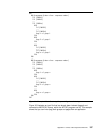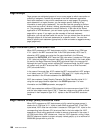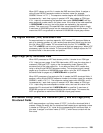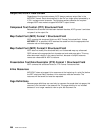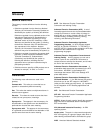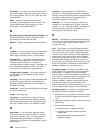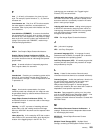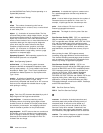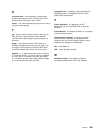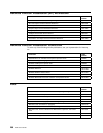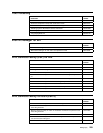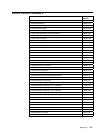and the MVS/390 Data Facility Product operating on a
System/390 processor.
MVS. Multiple Virtual Storage.
O
offset. The number of measuring units from an
arbitrary starting point in a record, area, or control block
to some other point.
object. (1) A collection of structured fields. The first
structured field provides a begin-object function, and the
last structured field provides an end-object function. The
object may contain one or more other structured fields
whose content consists of one or more data elements of
a particular data type. An object may be assigned a
name, which may be used to reference the object.
Examples of objects are text, graphics, and image
objects. (2) A resource or a sequence of structured
fields contained within a larger entity, such as a page
segment or a composed page.
Operating System/2. IBM's operating system for the
IBM Personal System/2 or a compatible.
OS/2. See Operating System/2.
outline fonts. (1) Fonts whose graphic character
shapes are defined as mathematical equations rather
than by raster patterns. (2) Fonts created in the format
described in
Adobe Type 1 Font Format
, a publication
available from Adobe Systems Inc. Synonymous with
Type 1 fonts.
overlay. A collection of predefined, constant data such
as lines, shading, text, boxes, or logos, that is
electronically composed and stored as an AFP resource
file than can be merged with variable data on a page
while printing or viewing.
P
page. Part of an AFP document bracketed by a pair of
Begin Page and End Page structured fields.
page definition. A resource containing a set of
formatting controls for printing logical pages of data.
Includes controls for number of lines per printed sheet,
font selection, print direction, and mapping individual
fields in the data to positions on the printed sheets.
page segment. An AFP resource that can contain text
and images, and can be included on any addressable
point on a page or electronic overlay. A page segment
assumes the environment of the object in which is it
included. See also image.
parameter. A variable that is given a constant value
for a specified application and that may denote the
application.
pitch. A unit of width of type, based on the number of
characters that can be placed in a linear inch. For
example, 10-pitch type has ten characters per inch.
point. A unit of about 1/72 of an inch used in
measuring typographical material.
point size. The height of a font in points. See also
point.
Print Services Facility (PSF). PSF is a sophisticated
IBM print subsystem that drives IPDS page printers.
PSF is supported under OS/390, MVS, VSE, VM, OS/2,
AIX, and is a standard part of the operating system
under OS/400. PSF manages printer resources such as
fonts, images, electronic forms, form definitions, and
page definitions, and provides error recovery for print
jobs.
When printing line data, PSF supports external
formatting using page definitions and form definitions.
This external formatting extends page printer functions
such as electronic forms and use of typographic fonts
without any change to applications programs.
Print Services Facility/2 (PSF/2). PSF/2 is an
OS/2-based print server that drives IPDS page printers
as well as IBM PPDS and HP-PCL compatible printers.
PSF/2 manages printer resources and provides error
recovery for print jobs. PSF/2 supports distributed
printing of AFP print jobs from PSF for OS/390,
PSF/MVS, PSF/VSE, PSF/VM, and OS/400. PSF/2 also
supports printing from a wide range of workstation
applications, including Microsoft Windows and OS/2
Presentation Manager, as well as the ASCII, PostScript,
and AFPDS data streams.
PSF. See Print Services Facility.
PSF/2. See Print Services Facility/2.
R
resource. A collection of printing instructions and
sometimes data to be printed consisting entirely of
structured fields. A resource can be stored as a
member of a library and can be called for by Print
Services Facility when needed. Coded fonts, font
character sets, code pages, page segments, overlays,
form definitions, and page definitions are all resources.
rotation. The number of degrees a graphic character
is turned relative to the page coordinates.
204 ACIF User’s Guide




